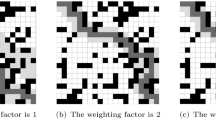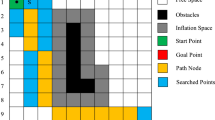Abstract
In this paper, a new path tracker is proposed for autonomous robots by re-designing a classical obstacle avoidance algorithm “Follow the Gap Method (FGM)”. Until now, FGM is not used to track a global plan of consecutive waypoints dynamically yet. On the other hand, this is a very fundamental requirement for autonomous robots. To use the FGM as a dynamic tracker, the proposed methodology is borrowing the “Look Ahead Distance” (LAD) from geometric path tracking methods and adapting it to the local planner. The LAD is defined as the distance from the robot to the desired waypoint on the path to be tracked. In the proposed solution, a dynamic and optimized LAD for the local planner is defined which is automatically adjusted by the robot velocity. The dynamic LAD function is optimized to increase tracking, avoidance, and comfort capabilities. This study is the first one that uses FGM together with a global planner as part of a whole autonomous system. Another novelty of the paper is the optimization of LAD. In this study, the LAD is optimized by taking into account not only the tracking error but also the distance to obstacle and comfort metrics simultaneously, for the first time in literature. The optimization is performed with various weight coefficients in the cost function. Three metrics are used to compare the effect of weight coefficients on the optimization. These metrics are the Root Mean Square (RMS) values of “Distance to Path”, “Distance to Obstacle” and “Magnitude of Total Acceleration”. For instance according to the experiments, when the tracking coefficient is doubled in optimization, the distance to path metric comes from 0,424m to 1,23m, indicating that the robot is tracking better. Similar effects on other metrics are observed when the related coefficients are changed. Besides the simulations, real-world experiments are performed on the real autonomous wheelchair platform to show the real-time performance of the proposed approach.
Similar content being viewed by others
Explore related subjects
Discover the latest articles, news and stories from top researchers in related subjects.References
Kowalczyk, W., Michałek, M., Kozłowski, K.: Trajectory tracking control and obstacle avoidance for a differentially driven mobile robot, 44. https://doi.org/10.3182/20110828-6-IT-1002.03567 (2011)
Michałek, M., Kozłowski, K.: Vector-field-orientation feedback control method for a differentially driven vehicle. IEEE Transactions on Control Systems Technology. 18. https://doi.org/10.1109/TCST.2008.2010406 (2010)
Khatib, O.: Real-time obstacle avoidance for manipulators and mobile robots. International Journal of Robotics Research. 5. https://doi.org/10.1177/027836498600500106 (1986)
Sruthi, M.I., Jisha, V.R.: Trajectory tracking and obstacle avoidance of a mobile robot based on vector field. https://doi.org/10.1109/ICCICCT.2015.7475270 (2016)
Creed, B.C., Arsenault, A., Velinsky, S.A., Lasky, T.A.: Obstacle avoidance for autonomous mowing. Mechanics Based Design of Structures and Machines 40. https://doi.org/10.1080/15397734.2012.685441 (2012)
Kohl, A.M., Moe, S., Kelasidi, E., Pettersen, K.Y., Gravdahl, J.T.: Set-based path following and obstacle avoidance for underwater snake robots, vol. 2018-January. https://doi.org/10.1109/ROBIO.2017.8324582 (2018)
Wang, Z., Wu, Q.: Tracking and obstacle avoidance control of a second-order system with smc, 1. https://doi.org/10.1109/IHMSC.2014.47 (2014)
Kim, D.H., Han, C.S., Lee, J.Y.: Sensor-based motion planning for path tracking and obstacle avoidance of robotic vehicles with nonholonomic constraints. In: Proceedings of the institution of mechanical engineers part c:, journal of mechanical engineering science 227. https://doi.org/10.1177/0954406212446900 (2013)
Li, X., Zhu, S., Aksun-Guvenc, B., Guvenc, L.: Development and evaluation of path and speed profile planning and tracking control for an autonomous shuttle using a realistic, virtual simulation environment. J Intell. Robot Syst. 101(2), 1–23 (2021)
Li, X., Sun, Z., Liu, D., Zhu, Q., Huang, Z.: Combining local trajectory planning and tracking control for autonomous ground vehicles navigating along a reference path. https://doi.org/10.1109/ITSC.2014.6957775 (2014)
Li, S., Li, Z., Yu, Z., Zhang, B., Zhang, N.: Dynamic trajectory planning and tracking for autonomous vehicle with obstacle avoidance based on model predictive control. IEEE Access 7. https://doi.org/10.1109/ACCESS.2019.2940758 (2019)
Hu, C., Zhao, L., Cao, L., Tjan, P., Wang, N.: Steering control based on model predictive control for obstacle avoidance of unmanned ground vehicle. Measurement and Control (United Kingdom) 53. https://doi.org/10.1177/0020294019878871 (2020)
Sezer, V., Gokasan, M.: A novel obstacle avoidance algorithm: “follow the gap method”. Robotics and Autonomous Systems 60. https://doi.org/10.1016/j.robot.2012.05.021 (2012)
O’Kelly, M., Abbas, H., Harkins, J., Kao, C., Pant, Y.V., Mangharam, R., Babu, V.S., Agarwal, D., Behl, M., Burgio, P., Bertogna, M.: F1/10: An Open-source Autonomous Cyber-physical Platform (2019)
Wang, Y., She, W., Fu, M., Ding, F., Dai, S.: Real-time obstacle avoidance of hovercraft based on follow the gap with dynamic window approach. https://doi.org/10.1109/OCEANS.2018.8604720 (2019)
Demír, M., Sezer, V.: Design and implementation of a new speed planner for semiautonomous systems. Turkish Journal of Electrical Engineering and Computer Sciences 26. https://doi.org/10.3906/elk-1708-127 (2018)
Zohaib, M., Pasha, M., Riaz, R., Javaid, N., Ilahi, M., Khan, R.: Control strategies for mobile robot with obstacle avoidance. arXiv:1306.1144 (2013)
Demir, M., Sezer, V.: Improved follow the gap method for obstacle avoidance. https://doi.org/10.1109/AIM.2017.8014220 (2017)
Ozdemir, A., Sezer, V.: A hybrid obstacle avoidance method: follow the gap with dynamic window approach. https://doi.org/10.1109/IRC.2017.25 (2017)
Coulter, R.C.: Implementation of the pure pursuit path tracking algorithm Communication (1992)
Park, M.W., Lee, S.W., Han, W.Y.: Development of lateral control system for autonomous vehicle based on adaptive pure pursuit algorithm. https://doi.org/10.1109/ICCAS.2014.6987787 (2014)
Ohta, H., Akai, N., Takeuchi, E., Kato, S., Edahiro, M.: Pure pursuit revisited: Field testing of autonomous vehicles in urban areas. https://doi.org/10.1109/CPSNA.2016.10 (2016)
Park, J.B., Bae, S.H., Koo, B.S., Kim, J.H.: When path tracking using look-ahead distance about the lateral error method and the velocity change method tracking comparison. https://doi.org/10.1109/ICCAS.2014.6987822 (2014)
Kuwata, Y., Teo, J., Karaman, S., Fiore, G., Frazzoli, E., How, J.P.: Motion planning in complex environments using closed-loop prediction. https://doi.org/10.2514/6.2008-7166 (2008)
Ahn, J., Shin, S., Kim, M., Park, J.: Accurate path tracking by adjusting look-ahead point in pure pursuit method. Int. J Auto. Technol. 22(1), 119–129 (2021)
Chen, L., Liu, N., Shan, Y., Chen, L.: A robust look-ahead distance tuning strategy for the geometric path tracking controllers, vol. 2018-June. https://doi.org/10.1109/IVS.2018.8500623 (2018)
Li, T., Hu, J., Gao, L., Liu, X., Bai, X.: Agricultural machine path tracking method based on fuzzy adaptive pure pursuit model. Nongye Jixie Xuebao/Transactions of the Chinese Society for Agricultural Machinery 44. https://doi.org/10.6041/j.issn.1000-1298.2013.01.039 (2013)
Powell, J.P., Palacín, R.: Passenger stability within moving railway vehicles: Limits on maximum longitudinal acceleration. Urban Rail Transit 1. https://doi.org/10.1007/s40864-015-0012-y (2015)
Eboli, L., Mazzulla, G., Pungillo, G.: Measuring bus comfort levels by using acceleration instantaneous values, 18. https://doi.org/10.1016/j.trpro.2016.12.004 (2016)
Bae, I., Moon, J., Jhung, J., Suk, H., Kim, T., Park, H., Cha, J., Kim, J., Kim, D., Kim, S.: Self-driving like a human driver instead of a robocar:, Personalized comfortable driving experience for autonomous vehicles. arXiv:2001.03908 (2020)
Hatab, R.D.A.A.: Dynamic modelling of differential-drive mobile robots using lagrange and newton-euler methodologies: A unified framework. Advances in Robotics and Automation 02. https://doi.org/10.4172/2168-9695.1000107 (2013)
Demir, A., Sezer, V.: Motion planning and control with randomized payloads on real robot using deep reinforcement learning, 13. https://doi.org/10.1142/S1793351X19400233 (2019)
Sezer, V., Ercan, Z., Heceoglu, H., Bogosyan, S., Gokasan, M.: A new fuzzy speed planning method for safe navigation. https://doi.org/10.1109/ICVES.2012.6294308 (2012)
Goldberg, D.E., Samtani, M.P.: Engineering optimization via genetic algorithm (1986)
N, F.: Global optimization with MATLAB. Create space independent publishing platform ???. https://books.google.com.tr/books?id=eHYaMQAACAAJ (2016)
Sezer, V., Zengin, R.S., Houshyari, H., Yilmaz, M.C.: Conversion of a Conventional Wheelchair Into an Autonomous Personal Transportation Testbed. https://doi.org/10.5772/intechopen.93117
Quigley, M., Conley, K., Gerkey, B., Faust, J., Foote, T., Leibs, J., Wheeler, R., Ng, A.Y.: Ros: an open-source robot operating system, 3 (2009)
Fox, D., Burgard, W., Dellaert, F., Thrun, S.: Monte carlo localization: Efficient position estimation for mobile robots. AAAI/IAAI 1999(343-349), 2–2 (1999)
Karaman, S., Frazzoli, E.: Incremental sampling-based algorithms for optimal motion planning, 6. https://doi.org/10.15607/rss.2010.vi.034 (2011)
Acknowledgements
This work was supported by the Turkish Scientific and Technological Research Council (TUBITAK) under project no. 121E537.
Funding
This work was supported by the Turkish Scientific and Technological Research Council (TUBITAK) under project no. 121E537.
Author information
Authors and Affiliations
Contributions
Volkan Sezer made the manuscript and did the research.
Corresponding author
Ethics declarations
Conflict of interest/Competing interests
Author Volkan Sezer received research support from Turkish Scientific and Technological Research Council (TUBITAK).
Additional information
Publisher’s Note
Springer Nature remains neutral with regard to jurisdictional claims in published maps and institutional affiliations.
Rights and permissions
About this article
Cite this article
Sezer, V. An Optimized Path Tracking Approach Considering Obstacle Avoidance and Comfort. J Intell Robot Syst 105, 21 (2022). https://doi.org/10.1007/s10846-022-01636-x
Received:
Accepted:
Published:
DOI: https://doi.org/10.1007/s10846-022-01636-x




